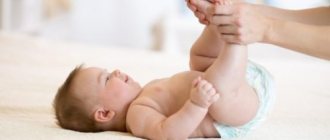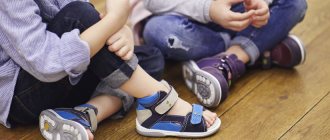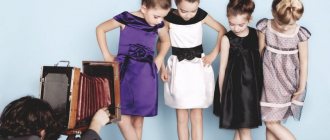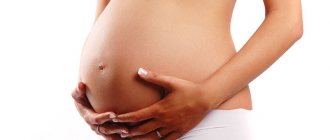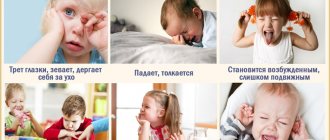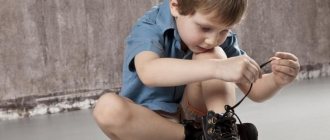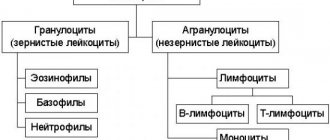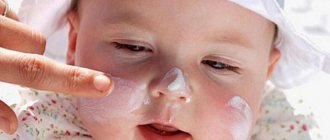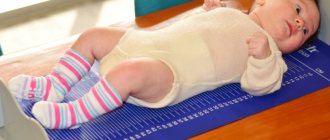Clubfoot is a persistent deformity of the foot and ankle joint, congenital or acquired, in which a person cannot place the sole flat on the floor due to the fact that it is “turned” inward and bent at the sole, while the heel is raised up.
The arrangement of the bones, muscles and ligaments of the foot in this pathology is grossly disturbed, mobility in the ankle is sharply limited. All this leads to disruption of the musculoskeletal function of the lower limb and a specific gait - with support not on the entire sole, but only on its outer edge.
Most often, clubfoot is congenital, but it can also be acquired and occur in adults due to injuries and other diseases of the musculoskeletal system and nervous system.
The congenital form of the pathology is 2 times more common in boys and, as a rule, is bilateral, in contrast to acquired variants of the defect.
With clubfoot, the development of the bones of the foot, its muscles and ligaments is disrupted
Signs of clubfoot
Foot deformity manifests itself in the child’s inability to place his heels flat on the floor. When walking, a curvature of the foot is detected in such a way that the outer edge drops and the inner edge rises. As a result, the foot of clubfooted children is in an incorrect position. In addition, the mobility of the ankle is impaired, and the gait becomes very peculiar. If such symptoms are detected when the child is one year old, as soon as he begins to walk, we should talk about hallux valgus.
Parents who carefully monitor their baby can independently identify the presence of a problem.
The following signs indicate clubfoot:
- Transverse fold on the foot.
- The toes curl inward.
- The foot appears short and swollen.
- There is a pronounced bend in the plantar direction.
- The foot is unnaturally turned.
The child has difficulty walking. Deformation of one foot causes first lameness, then curvature of the spine. With bilateral clubfoot, the baby is forced to move, taking too small steps. At the same time, he quickly gets tired and complains of pain in his legs. When clubfoot in children, signs can be seen in the prints left when walking barefoot - the socks point inward, the main support is the outer side of the foot.
Classification
It is inappropriate to begin treatment without specifying the extent of the disease.
In total, there are 3 forms of clubfoot:
- Mild (varus contractures). The mobility of the ankle joint and toes is practically not impaired. The angle of the foot does not exceed 15 degrees. Minor changes can be resolved without any problems.
- Medium (soft woven). The ability to move the ankle joint is difficult, the angle of the foot is up to 30 degrees. Corrections are possible, however, some deformation remains.
- Heavy (bone). Any movement of the ankle causes difficulties for the child. The foot is inclined at an angle of more than 35 degrees. Correction is impossible, which can lead to serious complications.
Any degree of disease requires immediate medical attention. When conservative treatment does not help, surgery cannot be avoided.
What is associated with clubfoot?
A distinction is made between congenital and acquired pathology. In the first case, the deformation occurs during intrauterine development. Clubfoot in newborns is usually observed on both legs.
The causes of congenital deformity are the following factors:
- Mechanical – if the fetus is not positioned correctly, increased pressure from the uterus on the feet occurs.
- Genetic. One of the reasons why a child is clubfoot is Edwards syndrome, which occurs as a result of changes in the number of chromosomes, which leads to the formation of many pathologies.
- Neuromuscular. These include various disorders in the development of muscles, ligaments, vitamin deficiency, and drug use by a woman during pregnancy. Work in hazardous industries, taking certain medications prohibited for pregnant women, and previous infectious diseases contribute to the formation of pathology.
Less common is childhood clubfoot, acquired when the foot becomes deformed during life. Violations begin to appear already in the second year of the baby’s life. His gait becomes clumsy; when walking, one leg seems to be raking. The placement of the foot is incorrect - the toe is turned inward.
There are several reasons why a child has clubbed legs:
- Injuries, improper fusion of bones during a fracture.
- Insufficient bone development, dysplasia.
- Rickets.
- Polio.
- Diseases of the nervous system.
- Muscular paralysis.
- Tumor formations.
Clubfoot is associated with the stress that a child's legs experience, especially after 2 years. Bones grow faster than muscle tissue. As a result, some muscles are toned, others are more relaxed, which leads to curvature of the foot. What to do if a child has a clubbed leg , the doctor will tell you after the examination.
Congenital clubfoot is detected using ultrasound performed in the last stages of pregnancy. The final diagnosis is made only after birth. For this purpose, an x-ray may be prescribed (not earlier than at the age of 3 months) as well as a computed tomography. Based on the diagnosis , on how to treat clubfoot.
Types of pathology
Most often, clubfoot in children is classified according to severity. This is necessary in order to determine the effectiveness of conservative therapy. There are the following types of pathology:
- a mild degree of clubfoot is the case when it can be cured at home with the help of massage and gymnastics, since mobility in the ankle joint is preserved and bone deformations are not pronounced;
- moderate severity requires professional treatment, since there is damage to the ankle joint, bone deformation and underdevelopment of muscles and ligaments;
- severe clubfoot is most often bilateral, as it occurs due to congenital defects in the development of the musculoskeletal system;
- a very severe degree leads to disability of the child; it cannot be eliminated even by surgical methods.
Congenital clubfoot occurs due to underdevelopment of muscles and ligaments
In addition, different types of pathology are distinguished depending on the cause that caused it. This may be congenital clubfoot due to underdevelopment of muscles, ligaments or defects in skeletal bones. There is also acquired clubfoot, which most often develops at the age of 2-3 years. In adults, the disease is very rare, since complete ossification of the foot occurs in adolescence.
Treatment methods
The methods used to eliminate foot defects are designed to correct clubfoot and consolidate the result. It may take more than one year to finally resolve the problem.
Successful treatment is based on three main principles:
- Timeliness.
- Constant supervision by an orthopedist.
- Demonstration of patience and perseverance on the part of parents.
Measures aimed at correcting clubfoot in a child begin to be taken a week after birth. The simplest and most effective method is fixation with a plaster cast. It must be changed every week until the foot correction reaches the maximum possible level. The child's bones are still very soft, making adjustments possible.
To get rid of clubfoot at any age, including in infants, massage, physical therapy, and physiotherapeutic procedures are used. Treatment carried out comprehensively gives excellent results.
Therapeutic massage should only be performed by a qualified professional . The number of required sessions is determined by the orthopedist.
Physiotherapy includes procedures such as electrophoresis, magnetic therapy, electrical stimulation, phonophoresis. All of them help improve blood supply, tissue stretching and muscle fiber contraction.
You can start doing therapeutic exercises with your child from 3 weeks of age. The orthopedist will tell you what exercises you need to do.
If necessary , the doctor will tell you how to treat clubfoot in children using medications. Injecting Botox into the calf muscle allows you to relax it, as a result of which the foot takes the desired position. Compared to surgery, the effect of this method lasts no more than six months. However, at the initial stage, it allows you to cure clubfoot without painful procedures.
The appropriate method for correcting clubfoot in a child is selected only by the attending physician.
What should parents know about flat feet, club feet, bowed legs and shoes?
I am reposting the article because much of what is written here also applies to my children. Both of my girls “clubfoot” at the very beginning and sit with their legs tucked under them. This is our family trait. I was actively interested in these things, as well as everything related to legs, when Lyuba was little. I saw this article on the Rusmedserver and many other places. I decided to add it here, in case it helps someone breathe easier).
The article is based on materials published by the famous American orthopedist Staley on the website global-help.org
Flat feet
Parents worry about flat feet, but... flat feet are considered normal in most cases in newborn babies, older children, and adults. Special shoes, inserts, arch supports and exercises do not help increase the arch of the foot with mobile (physiological) flat feet.
Mobile flatfoot is a condition in which there is an unstable decrease in the arch, the foot is flexible, strong and has a good range of motion in the joints.
| Did you know? |
| One in five children will have a flattened arch for the rest of their lives. Most adults with mobile flatfoot have strong, pain-free feet. |
| Most children have flattening of the longitudinal arch of the foot due to increased mobility in the joints characteristic of childhood. When standing, the feet become flattened, and it seems that they “turn out” outward. |
| The arch of the foot is restored as soon as the child sits or stands on his toes |
| Just like normal children have different heights... | …normal arches of the feet also vary in height. |
Wearing inserts and arch supports for simple mobile flat feet can cause discomfort for a child when walking... and is frankly a waste of money.
The doctor will be concerned if your flat foot:
| tough | hurts | severe |
But an increased arch is an even bigger concern, as such feet can later cause pain with activity.
Clubfoot (intoeing)
Clubfoot is a term not known to official medicine (unlike clubfoot). This term was most likely invented by the parents themselves at the suggestion of illiterate doctors. By clubfoot, in most cases, parents mean that the child walks with his feet turned toes inward. Since there is no official name for this condition in Russian medicine, for brevity I will use the English version of intoing (intoeing - fingers inward).
Intoing is a very common phenomenon in children, which usually goes away as they grow older.
There are three causes of intoing, which the doctor can determine during the examination: 1. Curvature of the foot 2. Torsion (twisting) of the bones of the lower leg 3. Torsion of the femur
Curvature of the foot
The curvature of the foot is caused by the position of the fetus inside the uterus. Most positional curvatures of the feet go away on their own, without treatment, during the first months of a child’s life. Although in some cases, improvement in foot shape can continue until the age of three.
| 2 months | 6 months | 1 year |
In rare cases, when the curvature of the foot is severe, goes away slowly, and the foot is stiff, it is necessary to apply corrective plaster casts. Special boots do not lead to improvement in this situation.
Torsion of the shin bones
Torsion of the lower leg is the twisting of the bones of the lower leg, in this case inward, along its axis. This is a normal variant and is very common in newborns and young children. Orthoses, special exercises, braces or orthopedic shoes cannot correct the twisted bones and, in fact, can be harmful. In most children, the bones “straighten” on their own, without any treatment, in the first years of life.
Hip torsion
Femoral torsion is a twisting of the femur that causes internal rotation (turning) of the leg and intoing. Hip torsion is usually the cause of walking with the feet turned inward in children aged 5-6 years. For most children, the situation returns to normal by age 10. Shoe inserts, special orthopedic boots, or braces cannot reduce hip torsion or correct gait. But they can cause discomfort to the child, make the child feel sick and impair his mobility.
Curvature of the legs (O-shaped and X-shaped legs)
During normal growth, a child's feet may take on different shapes. With the beginning of walking, O-shaped legs are often formed, which straighten on their own by the age of two. Some children develop X-shaped legs by the age of 1.5-2 years (knocked knees, in English literature). The vast majority of X and O-shaped legs straighten independently with age by 5-6 years. Shoe inserts, special orthopedic boots and exercises do not affect the growth process of the legs, but they can cause discomfort and make the child feel sick.
Only a competent orthopedist can decide whether there are any abnormalities in the growth of a child’s legs or not. The doctor may suspect a pathology if the deformity of the legs is severe, expressed predominantly on one side, or the curvature of the legs can be traced in other family members, especially if most close relatives are short in stature.
Shoes
People who walk barefoot have the best feet! Your child needs soft, flexible shoes that allow maximum freedom for normal foot development.
Shoe size
It is better to choose shoes that are a little looser than tight.
Rigid, “orthopedic” shoes are not suitable for the feet because they limit the movements necessary to develop strength and flexibility in the feet. A child's feet need protection from cold and damage from sharp objects, as well as freedom of movement.
Child falls can cause injury. Flat sole that does not stick to the floor and does not slide best.
| The material from which the shoes are made should allow maximum air to pass through, which is especially important for areas with hot climates. |
| Avoid buying oddly shaped shoes. Narrow-toed shoes, high heels and hard soles are harmful to the feet. |
Conclusion
Most parents' concerns about flat feet and bowed legs are unfounded. Development options are numerous and with age the legs take on their usual shape. Only a competent orthopedist can determine whether everything is normal with your child’s legs.
Remember
The best thing you can do for your child is to stimulate his physical activity and avoid overeating. Remember that the so-called corrective shoes, inserts, instep supports, braces, etc. - are ineffective and will only make your child unhappy. Let the magical powers of time and growth do their work. Treatment from Mother Nature is the safest, most inexpensive and effective.
Play is a child’s main job!
Cry from the heart
Surprisingly, such simple and logical truths are completely forgotten not only by parents but also by many orthopedists, pediatricians and neurologists. Every day we see unfortunate children shackled in high, hard orthopedic boots almost from the age of seven months. Poor mothers and fathers rush around clinics torturing their beloved babies with endless massages, electrophoresis and paraffins. Orthopedic salons happily rub their hands together, selling dozens of instep supports to one-year-old children!!!
A short story, taken as an illustration, from the babyblog website
| The child's mother complains: “What kind of attack on my child? Before we had time to deal with the burn, the doctor was “delighted” - the legs were crooked - X-shaped.((((((((((((. I myself would never have thought... well, yes... not slender, to put it mildly... but we’re not even that old. All the little ones - some walk like a clumsy bear, some walk in a different way... I was naive, I thought that this was how it should be. Up to 3 years, in any case... But it turned out - that’s how it is... Scooters and pushcars will be banned in the future. Only a bicycle. And in general, reduce the load on the legs to a minimum.” |
| Also, my favorite is to sit like this |
The doctor forbade the healthy child to move! He ordered the appropriate execution...
As they say, comments are unnecessary..
.
Much can be forgiven for parents whose parental duty obliges them to “cure” their healthy child at all costs, just because the baby’s gait or legs are not similar to the gait or legs of an adult. But how can we understand the mass of certified specialists who have no idea that a child is not a smaller copy of an adult, but a completely special organism that lives according to its own laws? Who else but doctors should know these laws and convince parents of what can and cannot be treated for small children.
Dr. Lynn Staley is a professor emeritus at the University of Washington, a distinguished pediatric orthopedist, and the author of numerous studies and books on pediatric orthopedics, including the world-famous Manual of Pediatric Orthopedics, which is a reference book for pediatric orthopedists in the United States and around the world. In recent
For years he has been actively involved in popularizing modern approaches
in pediatric orthopedics.
The translation was made by V. M. Kenis, head of the department of foot pathology, neuroorthopedics and systemic diseases of the Children's
Orthopedic Institute named after. G.I. Turner.
Original post: What Parents Should Know About Flatfeet, Intoeing, Bent Legs and Shoes for Children. Copyright © 1979 by Staheli, Inc. Reprinted 1983,1993. Second edition 2004 All rights reserved. Design: Lynn T Staheli, MD & Vincent S. Mosca, MD Children's Hospital and Regional Medical Center, Seattle, Washington, USA
Taken here
Orthopedic shoes
Used to consolidate the corrective effect. Purchased at a specialty store.
Basic requirements for orthopedic shoes:
- Availability of hard backs.
- The pads must provide the necessary support for the foot.
- The boots should be high and rigid.
- Presence of arch supports.
- Socks are spread out to the sides.
For prevention, special pronator insoles are suitable. To prevent relapses, braces are used - Alpha Flex, Teddy Bear. They are boots with a metal strip that must be worn for 3 months, removed only for bathing.
Possible complications
The lack of therapeutic measures leads to the fact that clubfoot intensifies as the child grows, causing many problems. Foot deformation leads to improper development of muscles and bones. If a child has a clubfoot on one leg, it may be shorter than the other. Incorrect foot placement when walking leads to the formation of calluses and damage to the skin. Constant muscle tone causes severe pain in the baby. Added to this is curvature of the spine, changes in joints, and headaches. At the first symptoms you should consult a doctor.
Despite the fact that clubfoot in children belongs to the group of serious pathologies, timely treatment is successful in 90% of cases. Patience, trust in the attending physician and the perseverance of the parents are rewarded with the correct gait of the child and the normal development of the body in the future.
Main causes of clubfoot
Depending on the cause of clubfoot in a child, congenital and acquired defects are distinguished. The prerequisites for the development of the first type of pathology include:
- Severe toxicosis in the first trimester of pregnancy, when nerve endings are formed;
- Viral infections with body temperature above 38 degrees;
- Taking alcohol, medications without specialist supervision, smoking, drugs;
- Deficiency of vitamins and microelements;
- Excessive stress when carrying a child;
- Multiple pregnancy.
Acquired clubfoot in a baby can manifest itself as a result of rickets or bone dysplasia. Against the background of abnormal development of ligaments and muscles, lack of useful microelements, tumors, mental disorders. And also with excessive stress on the musculoskeletal system, severe tension on the lumbar muscles, wearing poor-quality shoes, serious injuries to the lower extremities.
Congenital spastic clubfoot in children develops against the background of pathological changes in the central and peripheral nervous system of the baby. The causes of clubfoot gait are cerebral palsy, congenital short Achilles tendon, weakness of ligaments and muscles.
Causes of clubfoot development
